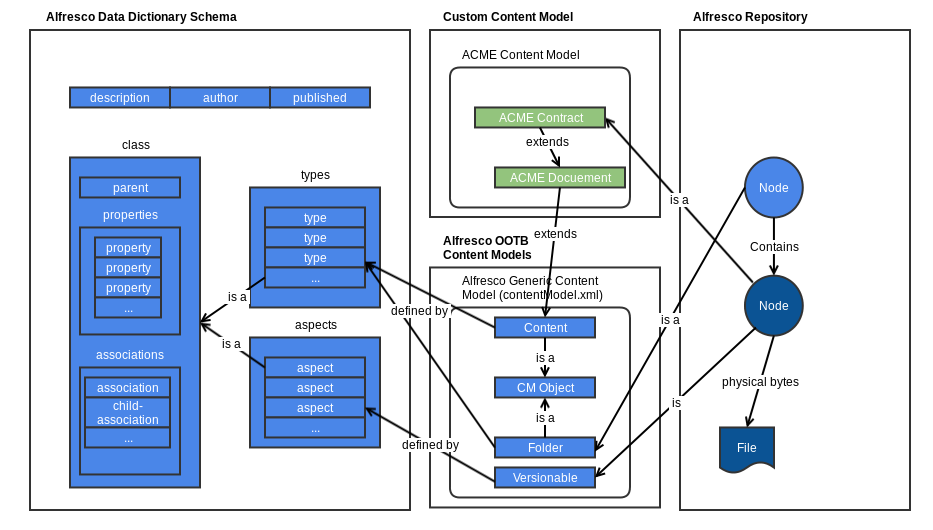| Information | Content Model Introduction |
|---|---|
| Support Status | Full Support |
| Architecture Information | Platform Architecture |
| Description |
One of the main differences between a network drive and a Content Management System (CMS) is that the latter provides extra classification features. If you look at a CMS behind the scenes, you can see that everything in the repository is typically a node (a node is also sometimes referred to as an object). Properties are then set on the nodes so they become folders, files, categories, rules, forums, web pages, e-mails, people, groups, and so on. Classifying nodes makes performing operations on them more precise, so it is easier to search for them, so they can be displayed in the user interface correctly, and node-specific operations can be carried out. The properties that can be used to classify nodes (content), cannot be selected at random, as then the system would not know what each one of these properties represents. Because of this a content management system usually comes preconfigured with properties that can be used to classify content in the repository. These properties are usually organized into two groups called Types and Aspects. The main difference between types and aspects is that a node can only have one type applied but it can have multiple aspects applied. Nodes are not isolated within the repository. They are related to one another in different ways. How the nodes are related to each other is defined using Associations. A typical association that comes out-of-the-box with SkyVault is the one between a folder node and its child nodes, this type of association is a child-association. So when you start using SkyVault you can immediately organize folders and files into a hierarchy, like with a file system. The Types, Aspects, Properties, and Associations are in turn organized into models that we call Content Models. SkyVault comes with a number of Content Models out of the box for different things like general folder and file content, workflow-related content, records content, web content, and so on. It is also useful to be able to create content models related to specific domains such as Finance or Marketing. As the type of content that may be stored in the repository can vary, generic standard content models are provided that provide a basis on which to build custom content models for domain-specific purposes. New types and aspects are defined forming new custom content models. But how do you know how to specify a type and a property with, for example, a data type integer? SkyVault also comes with a Meta Model. The Meta model defines what syntax you can use when defining your content models. It will, for example, define the syntax for how a type or an integer property should be defined. The following diagram gives a simplified overview of the relationship between SkyVault meta model, SkyVault content models, and custom content models:
In the image, you can see two nodes in the repository: one folder node and one ACME Contract document node. The Contract type extends the ACME Generic Document type, or base type if you like, which in turn extends the SkyVault generic Content type. The Contract document node also has versioning turned on by having the Versionable aspect applied. Both the custom content model and the SkyVault content model is defined by the SkyVault Data Dictionary Schema, which is the same as the Meta Model. Content models, types, aspects, and properties are similar to object-oriented concepts in programming. If you are familiar with object-oriented modelling, then the concepts of content modelling should feel familiar. The SkyVault meta model contains the constructs or syntax that can be used to define content models, which are defined in XML. Important: From version 5.1 of SkyVault it is possible to create
custom content models from the SkyVault Share UI without the need to use XML.
These models can then be exported as XML and included in a build project. See
the Model Manager in Share Admin
Tools documentation for further information.
Now that we have introduced you to SkyVault content models you are probably eager to implement one, for detailed instructions on how to do that see the define and deploy section. When you have defined and deployed a content model you would want to be able to work with it from the Share UI, see the configure UI section for more information around this. |
| Deployment - App Server |
|
|
|
| More Information |
|
| Sample Code | |
| Tutorials |
|
| SkyVault Developer Blogs |
|
You are here
Content Model
Defining a custom content model for the SkyVault Repository is a fundamental
task in almost every content management project. It will allow you to build a robust system
with content that can be classified, searched, structured, and processed in many different
ways.
© 2017 TBS-LLC. All Rights Reserved. Follow @twitter

